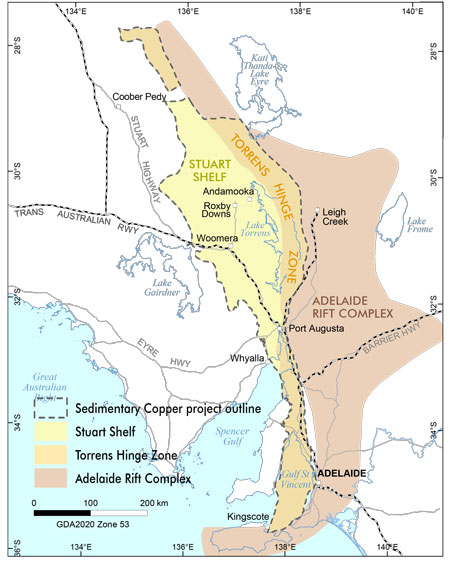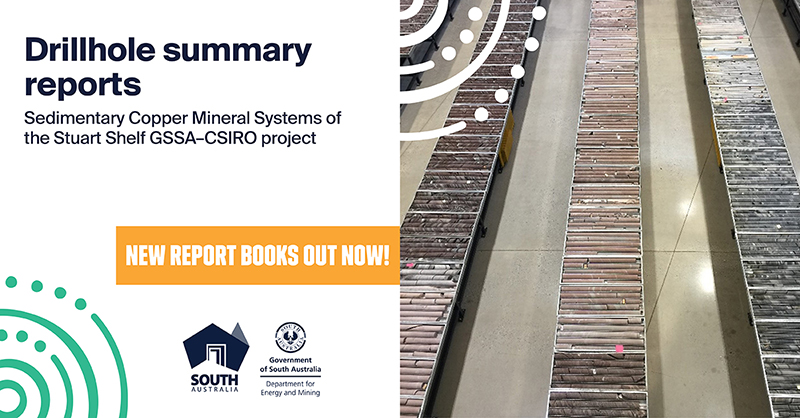The GSSA has partnered with CSIRO on this joint project to develop a robust model and understanding of the basin architecture of the Stuart Shelf to guide exploration for sedimentary copper in this area.
Project summary
Sedimentary-hosted copper deposits are the second most important source of copper in the world and the Stuart Shelf has long been considered as having considerable potential for sedimentary-hosted Cu resources due to similarities with the world-class African Copperbelt.
The project will improve knowledge of the basin architecture and distribution, thickness and depth of key lithostratigraphic units within the Neoproterozoic and older underlying basin deposits, which provide key control on the likely location of sedimentary copper mineralisation. This study will provide fundamental datasets and understanding to help explorers more readily explore for sedimentary copper deposits in South Australia.
25 drillholes from across the Stuart Shelf have been selected by a comprehensive screening process as the foundation for regional interpretation and the basin analysis. Liaising with exploration companies throughout the project will provide opportunities to access and include recent industry drill cores into this project.

Project diary
July 2023
New paper Geochronology and formal stratigraphy of the Sturtian Glaciation in the Adelaide Superbasin presents a large detrital zircon study for the Sturtian Glaciation, and revises the formal lithostratigraphic framework of the Yudnamutana Subgroup for South Australia. This paper incorporates observations and new age data from a drillhole the GSSA has been investigating as part of their Sedimentary Copper Mineral Systems of the Stuart Shelf project, in cooperation with CSIRO. As part of the paper, the authors investigated South Australian drillhole SR13/2 (DH 16794), housed at the South Australia Drill Core Library.
June 2023
GSSA Principal Geologist Adrian Fabris has co-authored a new open-access paper that utilises Lu-Hf dating in the Stuart Shelf. The paper, titled Laser ablation (in situ) Lu-Hf dating of magmatic fluorite and hydrothermal fluorite-bearing veins, is published in Geoscience Frontiers by lead author Stijn Glorie from the University of Adelaide.
The authors dated fluorite and calcite veins (some with chalcopyrite) on the Stuart Shelf at ~500 Ma using the Lu-Hf method, demonstrating fluid mobilisation in Neoproterozoic sediments (at least some being Cu-bearing) during the Delamerian Orogeny. We also got a ~1590 Ma age from similar veins at the Torrens Dam IOCG deposit.
May 2023
A significant amount of historical drillhole data on the Mount Gunson area is now available via SARIG:
- 573 historic drillholes
- 8,278 geochemistry samples
Also available for inspection are 291 newly added historical drill cores from the area at the South Australia Drill Core Reference Library. This new data provides a great resource in the search for critical minerals and sedimentary copper in South Australia.
April 2023
Dr Carmen Krapf presented the latest project details at the Geoconferences – Team WA Workshop Basin Hosted Mineral Systems.
Download the presentation (PDF, 23.6 MB)

Twenty-five drillholes across the Stuart Shelf have been re-logged and analysed to provide a new baseline dataset to unravel the basin architecture of the area.
Drillhole reports for all 25 include a summary of new logging and data collection, updated stratigraphic and facies logs, and detailed drill core photos for all relevant stratigraphic units. Newly collected handheld gamma and portable XRF data are also available for download and hyperlinks to Hylogger data are included.
March 2023
As part of Geoscience Australia’s Exploring for the Future’s 'Geochemistry for Basin Prospectivity' module, a study containing new geochemical data and associated sample metadata has been released. The data is from samples collected by the Baas Becking laboratories in the 1970s from deposits and surrounding areas in the Stuart Shelf. The legacy samples were reanalysed using modern analytical techniques and include potential source and host rocks.
December 2022
At Discovery Day 2022 Dr Susanne Schmid, one of our CSIRO partners, gave an update on our collaborative research in this project, including showcasing how facies analysis, diagenesis and geophysics improve our understanding of the Stuart Shelf basin evolution and copper mineralisation.
November 2022
Dr Susanne Schmid, CSIRO’s project leader of our joint sedimentary copper project, presented Copper exploration in sedimentary basins - reducing the search space using a mineral systems approach at a recent Mineral Exploration Group of Western Australia meeting. The talk also showcased the Stuart Shelf work currently being jointly undertaken.
September 2022
Dr Carmen Krapf gave a presentation on the project, including an updated stratigraphy and sequence stratigraphic interpretation for the Stuart Shelf at the Central Australian Basin Symposium in Darwin.
Download the CABS 2022 presentation (PDF, 15.6 MB)
August 2022
The sedimentary copper project has released two big updates, a 3D model and an interactive South Australian Neoproterozoic Sediment-hosted Copper Occurrence map.
Stuart Shelf Sedimentary Copper 3D model
This new dataset provides important stratigraphic surfaces in 3D for the project area within the Stuart Shelf.
These areas include:
- Top of the Pandurra Formation
- Top of Beda Basalt
- Top of Tapley Hill Formation
- Base of Whyalla Sandstone.
South Australian Neoproterozoic Sediment-hosted Copper Occurrence
For the first time, users are able to interact with this GSSA map using links to the MINDEP database. The map highlights 662 copper occurrences identified as being hosted in Neoproterozoic sediments and further classified as either dominantly stratabound or structurally controlled.
The majority of occurrences are located within the Adelaide Rift Complex, Torrens Hinge Zone and Stuart Shelf, and include the historic copper mines of Kapunda, Blinman and Mt Gunson.
May 2022
This month Dr Carmen Krapf presented to the Society of Economic Geologists on early results from the recently completed logging of 10,570 metres of drill core from the Stuart Shelf. This has included collecting thousands of points of gamma data, pXRF and core photography.
The presentation entitled Applying a Petroleum Systems Approach to re-evaluate South Australia’s sedimentary copper potential, was made in conjunction with Indrani Mukherjee from the University of Tasmania, who began the session with a talk on pyrite as an exploration tool for sediment-hosted copper, and Bert De Waele of Fortescue Metal Group, who is principal geologist for the Global Project Generation unit.
Data collection on this project is now complete, the final number are set out below.
| Drillholes logged (May 2022) | 25 |
| Drill core logged (metres) | 10570 |
| Drillholes Hylogged | 25 |
| Gamma data | 9245 |
| pXRF data | 4722 |
| Detailed core photos | 3540 |
|
Whole rock samples (Geoscience Australia – EFTF2) | 695 samples taken from 16 drillholes, with an additional 196 samples selected from a further 7 drillholes representing 42 distinct units |
March 2022
The project has progressed with an additional two drillholes logged since the last update. The project continues to collect additional samples, with additional results expected mid-year.
| Drillholes logged (March 2022) | 22 (of 25 for the project) |
| Drill core logged (metres) | 9530 |
| Additional drillholes Hylogged | 7 |
| Gamma data | 8630 |
| pXRF data | 4370 |
|
Whole rock samples (Geoscience Australia – EFTF2) | 396 samples taken from 7 drillholes, with an additional 250 samples selected from a further 5 drillholes representing 42 distinct units |
November 2021
This month the Geological Survey of South Australia and CSIRO hosted a hybrid workshop and core viewing session focused on sediment-hosted copper in the Stuart Shelf and Torrens Hinge Zone. The workshop included talks from the project team as well as industry and researchers working in the region. If you missed the workshop you can view it on our YouTube channel.
October 2021
Twenty of the 25 selected drillholes from across the Stuart Shelf have been logged in detail, including the recognition of 18 distinct facies. Drillhole logs have enabled preliminary cross-sections highlighting variation in unit distributions and thickness. Logging is complemented by pXRF, gamma, core photography and select whole rock and petrology samples.
| Drillholes logged (October 2021) | 20 (of 25 for the project) |
| Drill core logged (metres) | 9154.44 |
| Additional drillholes Hylogged | 6 |
| Gamma data | 8559 |
| pXRF data | 4220 |
| Petrology samples | 20 |
|
Whole rock samples (Geoscience Australia – EFTF2) | 258 samples taken from 6 drillholes, with an additional 579 samples selected from a further 16 drillholes representing 42 distinct units |
August 2021
19 of the 25 selected drillholes across the project area are re-logged with gamma and portable XRF readings taken.
June 2021
GSSA’s Dr Carmen Krapf gives a look at what is coming up in this project with CSIRO including a complete, new analysis of the entire basin.
March 2021
GSSA’s Adrian Fabris presents a talk on sediment-hosted deposits of the Southern Australian Craton as part of the CET online short course on basin-hosted base metal mineral systems.
Project resources
SedCu workshop
The GSSA hosted a one-day workshop in November 2021 to complement the work being done as part of this project. The workshop discussed sedimentary-hosted copper systems in South Australia with a focus on the Stuart Shelf.


